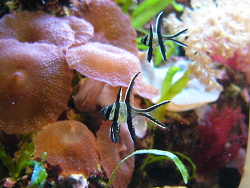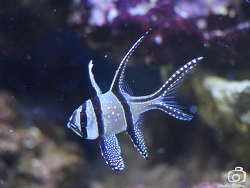Info
Koumans, 1933
Lives exclusivly near Banggai in the north of Sulawesi.
Young P. kauderni hide between the stings of Diadema sea hedgedogs or heliofungio corals where they are safe.
Susceptibly: Very transport-sensitive and delicately during accustomisation. Then again with good feeding very durable.
Social Behaviour: A swarmfish, which will stay close to his comrades in danger. Peaceful against other inhabitants.
Tank: Needs a well structured tank with hiding places. Well suitable for reef tanks.
The Banggai cardinalfish (Pterapogon kauderni) is a cardinalfish that grows to about eight centimeters long and lives in the sea only in a very small area east of the Indonesian island of Sulawesi. The entire area of occurrence covers an area of only 5,500 sq. km.
Aquaristic husbandry:
The Kauderni offspring like to seek shelter in the spines of the diadem sea urchins. This way they are better protected from attacks and attacks from larger fish. Like all cardinalfish the Kauderni are mouth brooders. The brood has about 5-40 eggs.
The animals must be kept as a pair, single keeping should not be, as well as keeping more than 2 animals. More than 2 usually leads to the death of the third animal.
Unfortunately, the Kaudernis are not very active in the aquarium, mostly they stand quietly in the tank and become active only when feeding.
Keeping them in the aquarium is absolutely easy. They accept all food and are not very sensitive to diseases.
The Kauderni was discovered late for marine aquaristics, it was about 1996 when it was shown for the first time at the Interzoo in Nuremberg.
Important:
The cardinalfish also preys on shrimp if the size is right.
Michael Mendler reports: Hello everybody, my name is Michael Mendler and I live near Ulm. Since 2 years I run successfully a seawater aquarium. Since 1 year I am engaged in breeding Pterapogon kauderni.
Shortly before Christmas I saw that one had its mouth full again. But since Christmas stress was just around the corner, I left the Kauderni in my reef aquarium.
On 26.12. I discovered 3 small babies near the surface and caught them out with the net and put them into the rearing tank.
When I wanted to start Artemia, I had to realize to have none in the house. At my dealer in the proximity also none was to be gotten. So I ordered via internet. But what to do, as long as there is no live food in the house? I tried all kinds of small frozen food. And lo and behold, lobster eggs seemed to tell them, really hard to believe. Today, in January 2002, the three little ones are about 3cm long (see photo below). I even find that they grow faster than with live Artemia, although I always hatch them in a nutrient solution. I would be interested to know if anyone has also had such experiences with raising caudernis? Is it a coincidence?
Please don't buy any more wild catches, because the Pterapogon kauderni is on the verge of extinction.
Meanwhile, there are also stable populations of Banggai cardinalfish in the Lembeh Strait.
Lembeh is considered the main transshipment point for the perch, by accident a few years ago transport bags fell into the sea and the perch escaped.
TV report "The sea of the small muster", 3Sat on 27.7.2014.
Breeding information:.
As long as the young animals are still fed with Artemia, this should only be done under strong lighting, otherwise the greedy rascals can not distinguish the freshly hatched Artemia from the shells. So it happened to me 2 times. I fed the babies only under blue light. Suddenly one after the other shot through the tank, as if stung by a tarantula. Due to the stress, the fish then fell into a kind of faint and lay motionless on the ground. After 1 to 3 minutes one after the other got up again. I have also heard that after such a stress some animals did not swim any further. So when feeding such small fishes use enough light, best use peeled Artemia and don't stress the fish with a full belly.
And Michael added in 2002:
Since longer time I breed again and again Kaudernis. For this I catch with a mirror trap the mouth-brooding animal from my tank and transfer it into a rearing tank. So far the raising of the young ones always turned out to be quite laborious.
Shortly before Christmas I saw that one had its mouth full again. Da aber der Weihnachtsstreß vor der Tür stand, beließ ich den Kauderni in meinem Riffaquarium.
Anmerkung:
Meanwhile, there are also stable populations of Banggai cardinalfish in Lembeh Strait.
Lembeh is considered the main transshipment point for the perch, by accident a few years ago transport bags fell into the sea and the perch escaped.
TV report "The sea of the small muster", 3Sat on 27.7.2014.
Lives exclusivly near Banggai in the north of Sulawesi.
Young P. kauderni hide between the stings of Diadema sea hedgedogs or heliofungio corals where they are safe.
Susceptibly: Very transport-sensitive and delicately during accustomisation. Then again with good feeding very durable.
Social Behaviour: A swarmfish, which will stay close to his comrades in danger. Peaceful against other inhabitants.
Tank: Needs a well structured tank with hiding places. Well suitable for reef tanks.
The Banggai cardinalfish (Pterapogon kauderni) is a cardinalfish that grows to about eight centimeters long and lives in the sea only in a very small area east of the Indonesian island of Sulawesi. The entire area of occurrence covers an area of only 5,500 sq. km.
Aquaristic husbandry:
The Kauderni offspring like to seek shelter in the spines of the diadem sea urchins. This way they are better protected from attacks and attacks from larger fish. Like all cardinalfish the Kauderni are mouth brooders. The brood has about 5-40 eggs.
The animals must be kept as a pair, single keeping should not be, as well as keeping more than 2 animals. More than 2 usually leads to the death of the third animal.
Unfortunately, the Kaudernis are not very active in the aquarium, mostly they stand quietly in the tank and become active only when feeding.
Keeping them in the aquarium is absolutely easy. They accept all food and are not very sensitive to diseases.
The Kauderni was discovered late for marine aquaristics, it was about 1996 when it was shown for the first time at the Interzoo in Nuremberg.
Important:
The cardinalfish also preys on shrimp if the size is right.
Michael Mendler reports: Hello everybody, my name is Michael Mendler and I live near Ulm. Since 2 years I run successfully a seawater aquarium. Since 1 year I am engaged in breeding Pterapogon kauderni.
Shortly before Christmas I saw that one had its mouth full again. But since Christmas stress was just around the corner, I left the Kauderni in my reef aquarium.
On 26.12. I discovered 3 small babies near the surface and caught them out with the net and put them into the rearing tank.
When I wanted to start Artemia, I had to realize to have none in the house. At my dealer in the proximity also none was to be gotten. So I ordered via internet. But what to do, as long as there is no live food in the house? I tried all kinds of small frozen food. And lo and behold, lobster eggs seemed to tell them, really hard to believe. Today, in January 2002, the three little ones are about 3cm long (see photo below). I even find that they grow faster than with live Artemia, although I always hatch them in a nutrient solution. I would be interested to know if anyone has also had such experiences with raising caudernis? Is it a coincidence?
Please don't buy any more wild catches, because the Pterapogon kauderni is on the verge of extinction.
Meanwhile, there are also stable populations of Banggai cardinalfish in the Lembeh Strait.
Lembeh is considered the main transshipment point for the perch, by accident a few years ago transport bags fell into the sea and the perch escaped.
TV report "The sea of the small muster", 3Sat on 27.7.2014.
Breeding information:.
As long as the young animals are still fed with Artemia, this should only be done under strong lighting, otherwise the greedy rascals can not distinguish the freshly hatched Artemia from the shells. So it happened to me 2 times. I fed the babies only under blue light. Suddenly one after the other shot through the tank, as if stung by a tarantula. Due to the stress, the fish then fell into a kind of faint and lay motionless on the ground. After 1 to 3 minutes one after the other got up again. I have also heard that after such a stress some animals did not swim any further. So when feeding such small fishes use enough light, best use peeled Artemia and don't stress the fish with a full belly.
And Michael added in 2002:
Since longer time I breed again and again Kaudernis. For this I catch with a mirror trap the mouth-brooding animal from my tank and transfer it into a rearing tank. So far the raising of the young ones always turned out to be quite laborious.
Shortly before Christmas I saw that one had its mouth full again. Da aber der Weihnachtsstreß vor der Tür stand, beließ ich den Kauderni in meinem Riffaquarium.
Anmerkung:
Meanwhile, there are also stable populations of Banggai cardinalfish in Lembeh Strait.
Lembeh is considered the main transshipment point for the perch, by accident a few years ago transport bags fell into the sea and the perch escaped.
TV report "The sea of the small muster", 3Sat on 27.7.2014.







 Jim Greenfield, Großbritannien
Jim Greenfield, Großbritannien





















